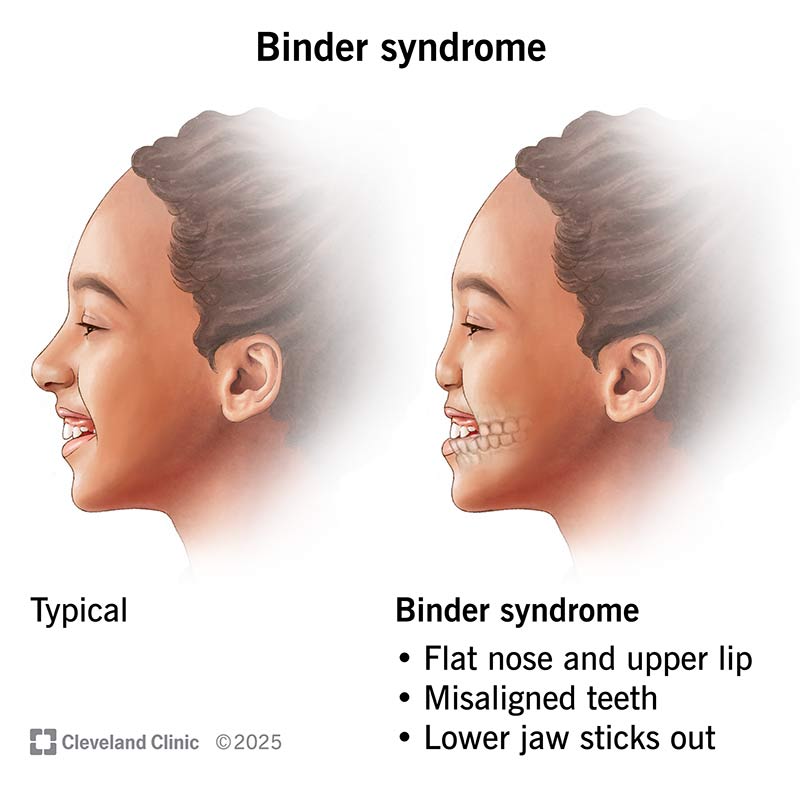Babies with Binder syndrome are born with flattened facial features, especially around the middle of their faces. Symptoms include a short, flat nose and an underdeveloped upper jaw. Orthodontic and surgical treatments during adolescence can help reshape and realign your child’s facial bones. The outlook is excellent with treatment.
Advertisement
Cleveland Clinic is a non-profit academic medical center. Advertising on our site helps support our mission. We do not endorse non-Cleveland Clinic products or services. Policy

Binder syndrome is a rare disorder that affects the bones of your face. It’s congenital, meaning it’s present at birth.
Advertisement
Cleveland Clinic is a non-profit academic medical center. Advertising on our site helps support our mission. We do not endorse non-Cleveland Clinic products or services. Policy
Babies with this condition have underdeveloped bones in their mid-face region. If your child has this condition, it may impact how they eat and breathe.
Binder syndrome is rare, occurring in less than 1 per 10,000 babies. Surgery during adolescence can help reconstruct facial bones.
Other names include:
This condition happens when the bones in the middle of your face don’t develop the way they should. Signs and symptoms vary from person to person but may include:
Experts don’t know the exact cause. They believe it could be a combination of genetic and environmental factors.
Risk factors that may increase your risk of having a baby with Binder syndrome include:
There’s no guaranteed way to make sure your baby isn’t born with Binder syndrome. But here are some guidelines for reducing the overall risk of birth defects (congenital conditions):
Advertisement
If you or someone in your biological family has Binder syndrome, you may want to consider genetic counseling. A genetic counselor can help assess your baby’s risk for the condition.
Because this condition affects the bones near the middle of your child’s face, they could experience difficulties with:
Your child’s healthcare provider will monitor these issues and recommend treatment if necessary.
Healthcare providers usually diagnose Binder syndrome based on your baby’s facial appearance. They may also take imaging tests to view your baby’s bone structure and confirm or rule out the diagnosis. These imaging tests may include:
Binder syndrome treatment varies based on symptoms and may include:
If your child has facial abnormalities, talk to their pediatrician right away. They can do an exam and run tests to get a diagnosis.
If you already know your baby has Binder syndrome, you’ll need to take them in for regular checkups. During these visits — which will continue into adolescence — your child’s care team will track their growth and design a treatment plan based on their unique needs.
Once your child is a teenager, they can typically begin orthodontics or have corrective surgery.
The outlook is generally positive. After treatment, most people don’t need to see their healthcare providers as often.
This condition doesn’t impact your life expectancy. People with the condition live just as long as people without it.
Some children with this condition have other health conditions, like:
If your child has Binder syndrome, it doesn’t automatically mean they’ll develop any of the above conditions. Ask your healthcare provider what to expect in your child’s situation.
If your baby was born with Binder syndrome, you might have lots of questions swirling around in your mind. Your healthcare provider is here to help. They’ll tell you how often to bring your child in for checkups. They can also help you understand what to expect as your child grows older and prepares for treatment.
Advertisement
If your child has conditions affecting their ears, nose or throat, you need experts on your side. Cleveland Clinic Children’s pediatric otolaryngologists can help.

Last reviewed on 11/03/2025.
Learn more about the Health Library and our editorial process.